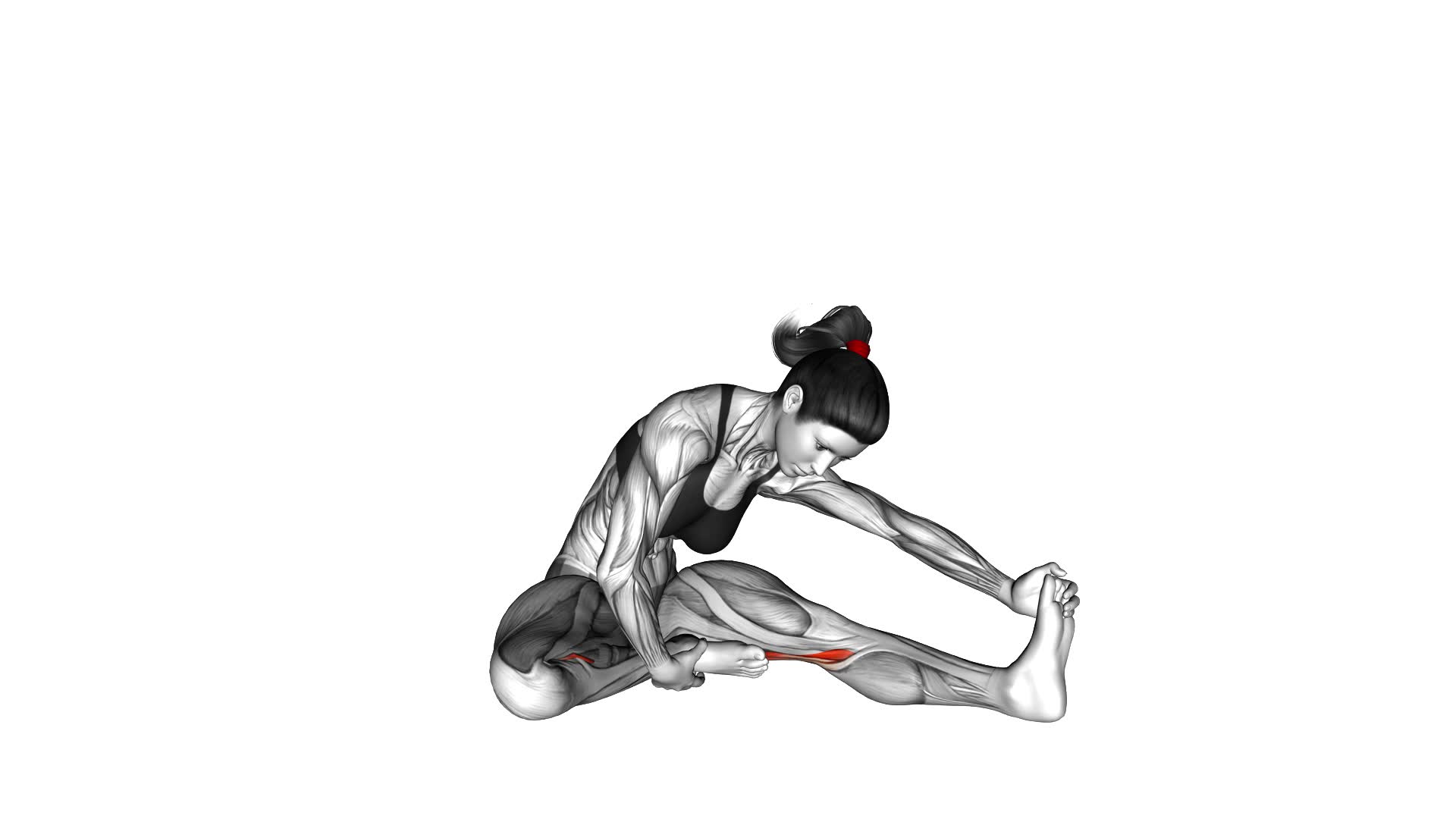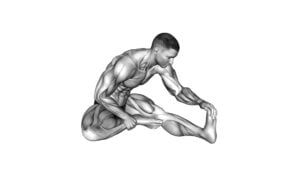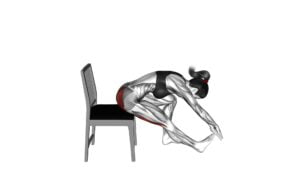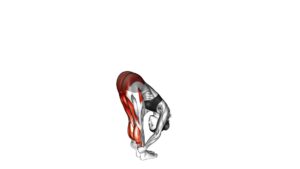Seated Single Leg Hamstring Stretch (female) – Video Exercise Guide & Tips

Looking to improve your flexibility and strengthen your hamstrings? Check out our video exercise guide on the seated single leg hamstring stretch.
Watch This Exercise Video
In this guide, we'll show you the proper technique, variations, and modifications for this exercise. Plus, we'll share valuable tips to help you get the most out of your stretch and avoid common mistakes.
Get ready to enhance your flexibility with this effective seated stretch!
Key Takeaways
- Seated single leg hamstring stretch improves flexibility in hamstrings.
- It helps prevent hamstring injuries and enhances athletic performance.
- The stretch promotes proper posture and maintains balance between strength and flexibility.
- Variations and modifications can be made to customize the stretch to individual needs.
Benefits of Seated Single Leg Hamstring Stretch
To maximize the effectiveness of your seated single leg hamstring stretch, you can experience a range of benefits. This stretch is an excellent way to improve flexibility in your hamstrings, allowing for a greater range of motion in your legs. By regularly performing this stretch, you can help prevent hamstring injuries, as it helps to lengthen and strengthen the muscles in the back of your thigh.
This increased flexibility can also improve your overall athletic performance, as it allows for better movement and stability in your lower body. Additionally, the seated single leg hamstring stretch helps to promote proper posture by stretching the muscles in your lower back and hips. By incorporating this stretch into your routine, you can maintain a healthy balance between strength and flexibility in your lower body.
Now that you understand the benefits of this stretch, let's move on to the proper technique for the seated single leg hamstring stretch.
Proper Technique for Seated Single Leg Hamstring Stretch
To perform the seated single leg hamstring stretch, sit on the floor with your legs extended in front of you. This stretch targets the hamstrings, which are the muscles located at the back of your thighs. Here are some key points to keep in mind for proper technique:
- Keep your back straight and tall throughout the stretch.
- Engage your core muscles to maintain stability and support your spine.
- Slowly lean forward from your hips, reaching towards your toes while keeping your leg extended.
Now, let's address some common misconceptions about seated hamstring stretches. One misconception is that you need to touch your toes to achieve an effective stretch. However, the goal is to feel a gentle pull or tension in your hamstring, rather than striving for extreme flexibility. Another misconception is that this stretch should be painful. While you may feel some discomfort, it should never be painful. If you experience pain, ease off the stretch.
To incorporate seated hamstring stretches into a full body stretching routine, you can follow these steps:
- Begin with a warm-up to increase blood flow to your muscles.
- Perform dynamic stretches for other muscle groups, such as arm circles or torso twists.
- Finish your routine with seated hamstring stretches and other static stretches to improve flexibility and cool down your body.
By incorporating seated hamstring stretches into your full body stretching routine, you can promote flexibility, reduce muscle tension, and improve your overall mobility.
Now, let's explore some variations and modifications for the seated single leg hamstring stretch.
Variations and Modifications for Seated Single Leg Hamstring Stretch
Try these variations and modifications to enhance your seated single leg hamstring stretch.
If you want to intensify the stretch, you can use a resistance band. Start by looping the band around the bottom of your foot and hold onto the ends with your hands. As you lean forward, the band will provide additional tension, increasing the stretch in your hamstring.
Another modification you can try is bending your knee slightly. This can help if you have tight hamstrings or limited flexibility. By bending your knee, you can still target the hamstring while reducing the strain on the muscles.
For those looking for advanced variations, you can experiment with different leg positions. For example, you can bring your other leg up and rest the ankle on top of the thigh of the stretched leg. This won't only target the hamstring but also engage the hip muscles.
Now that you know some variations and modifications, let's move on to some tips for getting the most out of your seated single leg hamstring stretch.
Tips for Getting the Most Out of Seated Single Leg Hamstring Stretch
To maximize the benefits of the seated single leg hamstring stretch, focus on maintaining proper form and gradually increasing your range of motion. Here are some tips to help you get the most out of this exercise:
- Engage your core: Keep your abdominal muscles activated throughout the stretch to stabilize your body and protect your lower back.
- Relax your shoulders: Avoid tensing up your shoulders and neck. Instead, let them relax and focus on the stretch in your hamstrings.
- Avoid common mistakes: Be mindful of these common mistakes to ensure you're performing the seated single leg hamstring stretch correctly:
- Rounding your back: Maintain a straight back throughout the stretch. Avoid rounding or hunching your shoulders.
- Jerking movements: Perform the stretch in a controlled and smooth manner. Avoid sudden jerking or bouncing motions that can strain your muscles.
- Overstretching: Gradually increase your range of motion over time. Avoid pushing yourself too far or forcing the stretch beyond your comfort zone.
Precautions and Common Mistakes to Avoid in Seated Single Leg Hamstring Stretch
Maintain proper form and avoid common mistakes to ensure you get the most out of the seated single leg hamstring stretch. When performing this stretch, it's important to take certain precautions to prevent injury and maximize the benefits.
One common mistake to avoid is rounding your back. It's crucial to keep your back straight and maintain good posture throughout the stretch. Rounding your back not only reduces the effectiveness of the stretch but also increases the risk of straining your back muscles.
Another common mistake isn't engaging the core. Your core muscles play a vital role in stabilizing your body during the stretch. By activating your core, you can improve your balance and increase the stretch's effectiveness.
Additionally, it's important to avoid bouncing or jerking movements while stretching. Instead, perform the stretch in a slow and controlled manner. Bouncing can lead to muscle strain and increase the risk of injury.
Lastly, listen to your body and don't push yourself too far. If you experience any pain or discomfort, ease off the stretch and modify it as needed. Remember to breathe deeply and relax into the stretch.
Frequently Asked Questions
Is the Seated Single Leg Hamstring Stretch Suitable for Everyone, Regardless of Age or Fitness Level?
The seated single leg hamstring stretch is a great exercise for improving flexibility and mobility in your hamstrings. It can be modified to suit people of all ages and fitness levels.
By incorporating this stretch into your daily routine, you can experience benefits such as increased range of motion, reduced muscle tightness, and improved posture.
It's important to listen to your body and make modifications as needed to ensure safety and effectiveness.
Can the Seated Single Leg Hamstring Stretch Help Improve Flexibility in Other Areas of the Body?
Improving overall flexibility is essential for maintaining a healthy body.
One effective way to achieve this is by incorporating hamstring stretches into your routine.
The seated single leg hamstring stretch is a great exercise that targets the hamstring muscles, but it can also benefit other areas of your body.
How Long Should I Hold the Stretch for Maximum Effectiveness?
To get the maximum effectiveness from the seated single leg hamstring stretch, hold the stretch for about 30 seconds to one minute. This duration allows your muscles to fully relax and lengthen.
Remember to breathe deeply and avoid bouncing or jerking movements. For beginners, you can modify the stretch by using a towel or strap to support your leg if needed.
Also, be mindful of common mistakes like rounding your back or locking your knee.
Are There Any Specific Breathing Techniques I Should Use During the Seated Single Leg Hamstring Stretch?
When doing the seated single leg hamstring stretch, it's important to focus on your breathing. Take deep breaths in and out, allowing your exhale to coincide with the stretch. This will help to relax your muscles and increase your flexibility.
Beginners can modify this stretch by using a strap or towel to assist in reaching their foot. Remember to listen to your body and never push yourself past your comfort zone.
Can the Seated Single Leg Hamstring Stretch Be Done as Part of a Warm-Up Routine Before Exercise?
Yes, the seated single leg hamstring stretch can be done as part of a warm-up routine before exercise. It helps to loosen up your hamstrings and prepare them for activity.
If you need modifications, you can use a strap to assist in the stretch or sit on a folded towel for extra comfort.
Alternatively, there are other hamstring stretches you can try, such as standing forward bends or lying hamstring stretches.
Conclusion
In conclusion, the seated single leg hamstring stretch is a beneficial exercise for improving flexibility and mobility in the hamstrings.
By following the proper technique and incorporating variations and modifications, you can customize the stretch to your individual needs.
Remember to listen to your body, avoid common mistakes, and seek guidance if you have any concerns or limitations.
With consistent practice and attention to detail, you can maximize the benefits of this exercise.

Author
Years ago, the spark of my life’s passion ignited in my mind the moment I stepped into the local gym for the first time. The inaugural bead of perspiration, the initial endeavor, the very first surge of endorphins, and a sense of pride that washed over me post-workout marked the beginning of my deep-seated interest in strength sports, fitness, and sports nutrition. This very curiosity blossomed rapidly into a profound fascination, propelling me to earn a Master’s degree in Physical Education from the Academy of Physical Education in Krakow, followed by a Sports Manager diploma from the Jagiellonian University. My journey of growth led me to gain more specialized qualifications, such as being a certified personal trainer with a focus on sports dietetics, a lifeguard, and an instructor for wellness and corrective gymnastics. Theoretical knowledge paired seamlessly with practical experience, reinforcing my belief that the transformation of individuals under my guidance was also a reflection of my personal growth. This belief holds true even today. Each day, I strive to push the boundaries and explore new realms. These realms gently elevate me to greater heights. The unique combination of passion for my field and the continuous quest for growth fuels my drive to break new ground.



